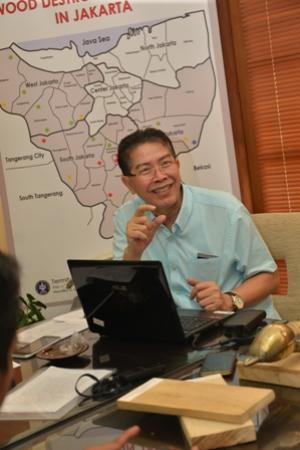Prof.Dr. Dodi Nandika One of the Professor Chair Holders of IPB: Indonesia is the Most Ideal Condition for Termites

Because the warm and soil conditions, including many kinds of plant species in Indonesia strongly supports the life of termites. Nearly 49 percent of Indonesia's land areas are covered by forest areas which is a natural habitat for termites. A total of 300 species of termites are identified in Indonesia, thus it is rated as 13% of the world's most species-rich terrestrial.
According to Professor Chair Holder of the Faculty of Forestry of Bogor Agricultural University (FAHUTAN-IPB), Prof.Dr. Dodi Nandika, in Indonesia from Sabang in Aceh to Merauke in West Papua, subterranean termites are found in every part of the country, in 45 cities or regions. Subterranean termites are social insects that live in societies whose members are mostly immature individuals. They are most abundant not only in the lowlands, but also in the highlands. Almost all large islands of Indonesia are infested by termites. Therefore it can be said Indonesia is the world's most important termite distribution territory. Indonesia is a haven where termites live. This was stated by Prof. Dodi Nandika in his scientific oration in the Auditorium of Andi Hakim Nasution, Campus Dramaga, Bogor, on 16 September 2015.
Six subterranean termite species that occur in ten cities in Indonesia, namely Sabang, Banda Aceh, Serang, Pandeglang, West Jakarta, South Jakarta, East Jakarta, South Jakarta, Bogor and Semarang Indonesia are Coptotermes curvignathus, Microtermes insperatus, Macrotermes gilvus, Capritermes mohri, Odontotermes javanicus and Schedorhinotermes javanicus.
"Subterranean termite particularly species of Coptotermes are widely recognized pests timbers in buildings in nine out of ten of the city in Indonesia. Such situation is really alarming," he said.
Jakarta were threatened by termites
Scientists of IPB revealed that four most subterranean termite species that occur in greater Jakarta are Coptotermes curvignathus, Microtermes insperatus, Macrotermes gilvus, Capritermes mohri. The highest species diversity is occur in East Jakarta.
Hazard level is an international classification for timber preservation. According termite hazard maps of Jakarta, there are six sub-districts in Jakarta that are rated into the Hazard Class I, six other districts rated into Hazard Class II and one sub-district is rated into the Hazard Class III.
Durability is not determined by the density or ‘hardness’ of the species. Designers can match the natural durability of a particular species with the hazard classification to specify an appropriate species for a specific application. Hazard Class I is area that is prone to termite attack on the building. Hazard Class II is area that is quite vulnerable to be attacked by termites, and Hazard Class III is area with low possibility to be attacked be termites.
"Hazard Level for Pesanggrahan, Kebayoran Baru, Mampang Prapatan, Pasar Minggu, Kramat Jati and Ciracas are rated into Hazard Level Class I. Whereas for Pancoran, Duren Sawit, Jatinegara, Palmerah, Kalideres dan Kembangan are rated into Hazard Level Class II. Finally Cengkareng is rated into Hazard Level class III," he explained.
How to prevent termite attack & termite damage on buildings in Jakarta? In 2013 the Governor of Jakarta issued the Governor Regulation (Pergub) on guidelines for hazard mitigation of termite on buildings belonging to the provincial government. This Governor Regulations was to enforce Law No. 28/2002 on building constructions and to address the structural damage caused by termites to buildings in Jakarta. “With the issuance of the gubernatorial decree, city agencies can propose a budget to handle termites. Previously, termite control was not mandatory,” (Wied)



